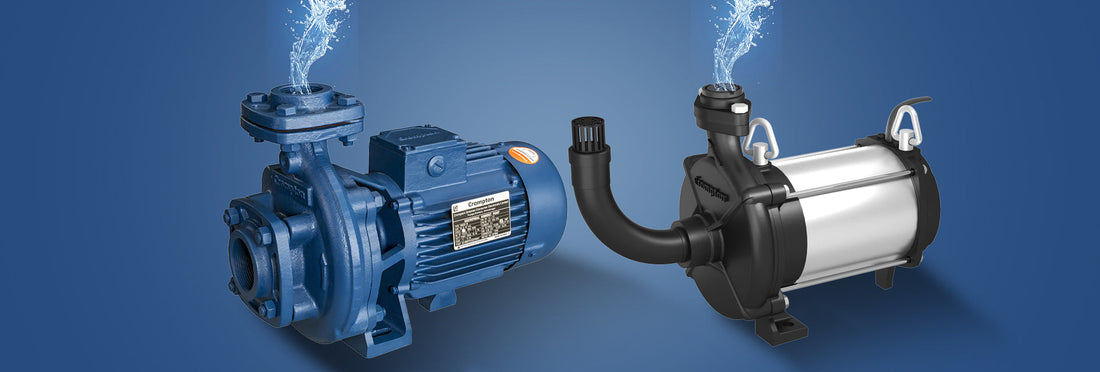Centrifugal Pump Vs. Submersible Pump: Know The Differences


Pumps are vital tools used in various industries for different purposes. They are designed to move liquids from one point to another, making it easier to transport and handle large volumes of liquids. Two of the most used pump types are centrifugal pumps and submersible pumps. While both pumps serve the same purpose, they differ in terms of their design, application, and performance. Let us do a comparison of centrifugal pumps vs. submersible pumps to explore the key differences between them. This will help you determine which pump type is best suited for your specific needs.
Centrifugal Pump Vs. Submersible Pump
Centrifugal pumps and submersible pumps are distinct in their design, operation, and applications within various industries.
-
Design and configuration
Centrifugal pumps are positioned above the water or liquid level. They consist of an impeller that imparts kinetic energy to the fluid, converting it into potential energy. In contrast, submersible pumps are entirely submerged in the fluid they are pumping. They feature a completely sealed motor encased in a watertight housing, allowing the pump to be immersed in the liquid. -
Working principle
Centrifugal pumps operate on the principle of centrifugal force. The spinning impeller accelerates the fluid radially outward, creating a flow of liquid. This kinetic energy is then converted into potential energy, resulting in the movement of the fluid. Conversely, submersible pumps use a combination of motor and impeller to draw in and push out the fluid. The sealed design ensures that the motor remains unaffected by the surrounding liquid. -
Installation and location
Centrifugal pumps are typically installed above ground and are suitable for applications where the pump can be situated at a higher elevation than the liquid source. They are commonly used for water supply and irrigation. Submersible pumps are installed within the fluid they are pumping. This design is advantageous in scenarios where the pump needs to be placed below the water level, such as in deep wells or sump pits. -
Efficiency and energy consumption
While centrifugal pumps are efficient, they may experience energy losses due to the need for a suction lift. The efficiency can vary based on the pump's design and specific application. Submersible pumps often exhibit higher efficiency as they operate without the limitations of suction lifts. The direct immersion in the fluid minimises energy losses associated with elevation changes.
The Difference in Applications of Centrifugal Pump and Submersible Pump
Centrifugal pumps and submersible pumps cater to diverse industrial needs, each excelling in specific applications based on their unique design and operational characteristics.
Centrifugal pump applications:
- Dewatering purposes: These are often employed in construction sites for dewatering purposes. Their portable and versatile nature makes them suitable for temporary installations to manage excess water during excavation or foundation work.
- Water supply and irrigation: Centrifugal pumps are widely employed for water distribution and irrigation systems. Their above-ground installation allows them to efficiently lift and transfer water over varying elevations, making them suitable for agricultural and municipal water supply.
- Chemical processing: Some centrifugal pumps are designed to handle corrosive and abrasive fluids, making them suitable for chemical processing industries. Their robust construction and ease of maintenance contribute to their effectiveness in managing diverse chemical substances.
- Aqua farming: Centrifugal pumps are utilised in aquaculture systems for water circulation, aeration, and maintaining optimal conditions for fish farming. Their ability to handle large volumes of water makes them valuable in aquaculture applications.
Submersible pump applications:
- Deep well pumping: Submersible pumps are well-suited for deep well applications, efficiently drawing water from significant depths. Their submerged design allows them to overcome the limitations associated with suction lifts, making them ideal for extracting water from deep reservoirs or boreholes.
- Wastewater treatment: Submersible pumps play a crucial role in wastewater treatment processes. Their sealed construction prevents contamination and allows them to handle the challenging task of pumping sewage and effluent in submerged conditions.
- Mining and construction: In mining operations, submersible pumps are utilised to handle water removal from pits or tunnels. Their capability to function submerged ensures efficient dewatering in environments where conventional pumps might be impractical.
- Aquaculture and fisheries: Submersible pumps are also used in fisheries for pond and tank aeration. Their submerged operation ensures efficient oxygenation without disrupting the water surface.
How To Determine Which Pump You Need?
Here are key steps to help you determine which pump best suits your needs:
Step 1: Understand the application requirements
Define the purpose of the pump. Whether you want to use it for water supply, irrigation, wastewater handling, and more.
Step 2: Consider fluid characteristics
Evaluate the properties of the fluid you intend to pump. Consider factors such as viscosity, temperature, and the presence of solids. Some pumps are better suited for handling certain fluid types or conditions.
Step 3: Examine depth and elevation changes
If the pumping involves significant depth or elevation changes, consider the limitations of centrifugal pumps. A centrifugal pump may require priming and face challenges with suction lifts. Submersible pumps, on the other hand, excel in scenarios with deep wells or submerged applications.
Step 4: Assess flow rate and pressure requirements
Determine the required flow rate and pressure for your application. Centrifugal pumps are known for their efficiency in delivering high flow rates at moderate pressures. Whereas submersible pumps are effective in providing consistent flow at various pressures.
Step 5: Evaluate space and installation constraints
Assess the available space for pump installation. Centrifugal pumps are typically installed above ground, making them suitable for applications with ample space. In contrast, submersible pumps are space efficient as they operate submerged, making them ideal for confined areas. However, you will need to dig a pit or borehole to install submersible pumps.
Step 6: Consult with experts
Seek advice from pump manufacturers, suppliers, or experts in the field. They can provide valuable insights based on your specific requirements and help you choose the most suitable pump for your application.
Takeaway
Centrifugal and submersible pumps both have their unique advantages and applications. However, it is important to carefully consider the specific requirements of your project before choosing the right type of pump. If you are looking for high-quality pumps for residential, agriculture, or commercial needs, Crompton offers a wide range of pumps to choose from. So, whether you are looking for a reliable pump for your home, farm, or business, you can find the perfect pump for your specific needs with Crompton.
Choose Crompton water pumps for excellent performance and dependability.
FAQs On Submersible Pump Vs Centrifugal Pump
-
Which is better, a submersible pump or centrifugal pump?
The choice depends on the application. Submersible pumps excel in deep well and submerged scenarios, while centrifugal pumps are versatile and widely used for various applications. -
What is the working principle of a submersible pump?
Submersible pumps operate by utilizing a sealed motor and impeller submerged in the fluid. The rotating impeller draws in and pumps out the fluid, making it efficient for deep well applications. -
Why is the centrifugal pump most used?
Centrifugal pumps are widely used due to their simple design, versatility, and efficiency. They are suitable for various applications, including water supply in households, irrigation purposes, and more, making them a popular choice across industries. -
How long does a centrifugal water pump last?
The lifespan of a centrifugal water pump depends on factors like usage, maintenance, and environmental conditions. With proper care, centrifugal pumps can last anywhere from 10 to 15 years on average. -
What is the working principle of a centrifugal pump?
The working principle of a centrifugal pump involves the conversion of rotational energy into kinetic energy. The pump's impeller rotates, creating a centrifugal force that propels fluid outward. As the fluid moves radially, it gains kinetic energy, leading to increased pressure and flow. This kinetic energy is then converted into potential energy, facilitating the continuous movement of the fluid through the pump.

 Read Previous Blog
Read Previous Blog



 at 9228880505 or write to us at
at 9228880505 or write to us at 